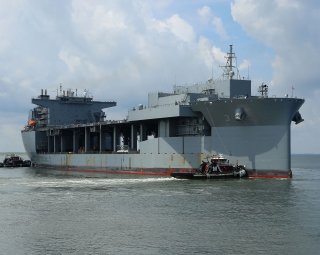Power Projection: The U.S. Navy Just Got Another Expeditionary Sea Base
These ships can bring new air support, logistics, and special forces support to overseas operations.
Helicopters, inflatable boats, surface attack drones and Special Ops teams can all launch from the U.S. Navy’s growing fleet of Expeditionary Sea Base Ships (ESB).
The Navy’s second ESB, the Hershel “Woody” Williams, has set sail for the African coast to bring expeditionary sea basing options to commanders in the region, according to a Navy statement cited in Seapower Magazine.
Sea basing possibilities in the African theater bring interesting new dimensions to tactical commanders operating in areas with fewer U.S. fixed landing sites or military installations from which aircraft and forces can conduct missions. Having an ability to deploy helicopters, surface drones and small teams of Navy SEALs will help the Navy accomplish its mission.
The U.S. Navy’s construction of ESBs reflects the service’s increased need to adjust to new kinds of land-based and maritime threats, including the changing character of amphibious warfare. Navy officials explain that ESBs, as well as some larger “mothership” amphibious assault ships, will function as seaports, floating hospitals, logistics warehouses and specific launching bases for expeditionary attacks.
The ESBs are engineered with a flat-top flight-deck helicopter landing area and side pocket areas from which to launch Rigid-Hull-Inflatable Boats for small, fast strike, rescue or reconnaissance missions. They also have ammunition storage, command and control facilities as well as a “reconfigurable mission deck area” to store force equipment such as mine sleds and small boats. The ESBs can also naturally function as floating command and control bases from which to operate attack missions or coordinate large fleets of autonomous surface, air or undersea drones.
Seabasing also introduces additional multi-domain operational flexibility, offering new points from which to attack, project power or launch small-boat Special Operations missions. For instance, the Commander of Air Force Combatant Command, General James Holmes, says it is important for cross-domain attack forces to decrease their dependence upon known, fixed-sites from which to operate near enemy territory.
The 784-foot-long Hershel “Woody” Williams “features a 52,000 square-foot flight deck, fuel and equipment storage, magazines, repair and mission-planning spaces. Its features include a four-spot flight deck, a mission deck and hangar, work and living spaces for a couple hundred staff and embarked personnel,” a Navy statement cited in the Seapower story reads.
Kris Osborn is the new Defense Editor for the National Interest. Osborn previously served at the Pentagon as a Highly Qualified Expert with the Office of the Assistant Secretary of the Army—Acquisition, Logistics & Technology. Osborn has also worked as an anchor and on-air military specialist at national TV networks. He has appeared as a guest military expert on Fox News, MSNBC, The Military Channel, and The History Channel. He also has a Masters Degree in Comparative Literature from Columbia University. This article first appeared earlier this year.
Image: Wikimedia.

